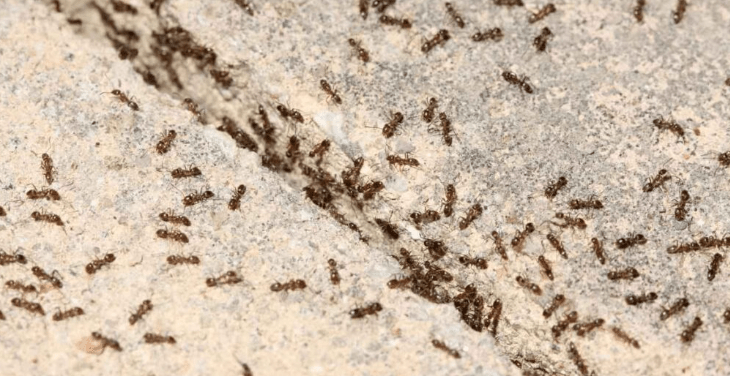Are you curious about ‘Tiny Bugs in Bathroom No Wings’ and its implications? Look no further! Our article serves as a comprehensive guide, presenting you with valuable insights and expert perspectives. Don’t miss out!
Unmasking the Tiny, Wingless Wonders

Ever wondered about those minuscule critters making your bathroom their habitat? Although not flying, these wingless insects have a mysterious charm about them. Let’s unravel the secrets of these microscopic bathroom inhabitants.
Identifying Common Tiny Bugs Found in Bathrooms Without Wings

Identification is always the first step. Most commonly, you might encounter Silverfish, Springtails, or even tiny ants. These are harmless, but their presence might be a sign of excess moisture or unhygienic conditions.
Understanding Why Wingless Bugs Choose Your Bathroom
Bathrooms offer a combination of warmth, humidity, and food sources, creating an ideal environment for these tiny pests. It’s not about your cleanliness standards, but more about the conditions your bathroom provides for these bugs to thrive.
Action Plan: Wave Goodbye to Your Wingless Visitors
Now that you’re familiar with these creatures, you might be wondering how to manage them. Fear not, we’ve got you covered!
How to Get Rid of Small, Wingless Insects in Your Bathroom
Keep your bathroom dry and clean. Regular cleaning, fixing any water leaks, and using a dehumidifier can significantly reduce their population. If the issue persists, consider professional pest control services.
Natural Remedies to Eliminate Wingless Pests
For those leaning towards environmentally friendly solutions, try some diatomaceous earth, which is non-toxic for humans and pets but lethal for many tiny bugs.
Prevention: The Key to a Bug-free Bathroom
Prevention is always better than cure. So, how can you prevent these tiny, wingless bugs from making a comeback?
Proactive Measures to Prevent Tiny Bugs from Invading Your Bathroom
Seal any cracks or holes, keep your drains clean, and maintain low humidity levels. Small steps can make a big difference in deterring these bugs from settling in.
Questions to Ponder: Are Wingless Bathroom Bugs Harmful?
Generally, bathroom bugs are harmless to humans. However, an uncontrolled infestation may lead to more significant pest problems.
Could Wingless Bathroom Bugs Indicate a Larger Pest Problem?
A sudden spike in their population might indicate a larger, underlying issue. If the numbers don’t decrease with regular cleaning and preventative measures, it’s time to call a professional.
Can Wingless Bathroom Bugs Transmit Diseases?
While most bathroom bugs are harmless, an infestation could lead to health issues related to allergies or asthma due to the bugs’ droppings or shed skin.
Life’s Little Mysteries: Zooming into the Lives of Tiny, Wingless Bathroom Bugs
After decoding the basics about these small wingless bugs, let’s delve deeper into the world of these unassuming creatures. Who are they, how do they live, and how can you co-exist with them, you wonder? Let’s unravel these life’s little mysteries together.
A Closer Look at Different Types of Wingless Bugs in the Bathroom
There’s a whole variety of tiny bugs without wings that you might encounter in your bathroom. Some of the most common ones include:
Silverfish
These insects are silver or brown, slim and elongated. They have a characteristic fish-like motion, hence the name Silverfish. They are primarily nocturnal and attracted to damp, humid areas.
Springtails
Springtails are extremely small, often light-colored bugs that are attracted to dampness and organic material. They can often be found near the bathroom sink or shower where moisture accumulates.
Booklice
Contrary to their name, booklice aren’t really lice. They’re tiny, soft-bodied insects that can often be found in damp and moldy areas. Bathrooms, especially ones with poor ventilation, can be a prime location for these pests.
Are Wingless Bathroom Bugs a Cause for Alarm?
Although they might look alarming, these microscopic critters are mostly harmless. However, a sudden or significant increase in their population could indicate underlying issues like moisture damage, leaky pipes, or poor sanitation. While they don’t transmit diseases directly, they might cause allergies in sensitive individuals.
Tiny Pests, Big Problems? The Impact of Bathroom Infestation Without Wings
While small in size, these bugs can indicate bigger problems. For instance, Silverfish are known to feed on mold. If you spot them frequently, it might be a sign of an underlying mold problem.
Similarly, a large presence of Springtails could indicate water damage somewhere, as they are drawn to moist environments. Ignoring these signs might lead to more serious issues down the line, like structural damage or health issues.
Building a Fortress: Essential Tips to Keep Your Bathroom Bug-Free
Now that you’re well versed with your tiny roommates, let’s go one step ahead. How do you fortify your bathroom against these tiny invaders?
Consistent Cleaning is Key
Regular and thorough cleaning is your first line of defense against these bugs. Regular cleaning helps remove potential food sources and disrupts any breeding grounds.
Balance the Humidity
Bathrooms are naturally humid, but you can manage this by improving ventilation and using a dehumidifier. Bugs thrive in high humidity, so keeping it low will make your bathroom less appealing to them.
Seal Potential Entry Points
Tiny bugs can enter through the smallest of cracks and crevices. Inspect your bathroom for any potential entry points and seal them promptly.
Regular Inspection and Maintenance
Regular inspection of your bathroom, along with timely maintenance of pipes, tiles, and grout, can prevent these bugs from establishing their home in your bathroom.
The Bug-friendly Bathroom: Co-existing with Our Tiny Friends
It’s essential to remember that bugs are a part of our ecosystem. While we don’t want them infesting our bathrooms, a few bugs here and there aren’t a cause for alarm.
In fact, they can even be beneficial, feeding on mold, dead skin cells, or other pests. As long as their population is in check, and they’re not causing any hygiene issues, there’s no harm in letting them be.
FAQs About Tiny Bugs in Bathroom No Wings
What are the signs of a small bug infestation in the bathroom?
An increase in the number of visible bugs, finding bugs in unusual places, or spotting bug droppings might indicate an infestation.
Do wingless insects in the bathroom indicate a larger pest problem?
A sudden increase in their numbers might indicate an underlying issue, requiring professional intervention.
Are there any natural remedies to eliminate wingless pests in the bathroom?
Natural remedies like diatomaceous earth can be used to control the population of these bugs.
Can wingless bathroom bugs transmit diseases?
While most bathroom bugs are harmless, an infestation could lead to health issues related to allergies or asthma.
Always remember, while these tiny bugs might be unwelcome visitors, understanding and managing them can open up a world of appreciation for the microscopic universe they represent.
Also Read: Which Element of Accenture’s Applied Quantum Computing Strategy Directly Delivers Value to Clients?
To Wrap Up: The Bathroom Ecosystem
Bathrooms, being warm and humid, naturally attract a host of tiny, wingless bugs. While they might be an inconvenience, understanding them, their habits, and lifestyles can help you control their population and even coexist peacefully. Just remember, the presence of a few bugs is a sign of a healthy ecosystem. However, if they’re causing issues or their numbers are spiraling out of control, it’s time to take action.
To sum it up, this article has shed light on various aspects of “Tiny Bugs in Bathroom No Wings” providing valuable insights and answering your most pressing questions.










